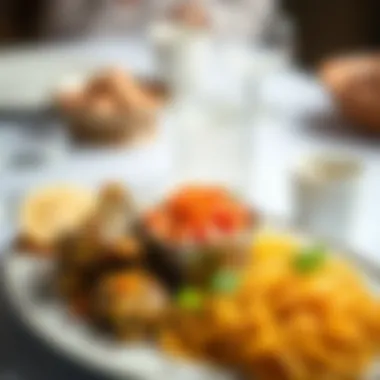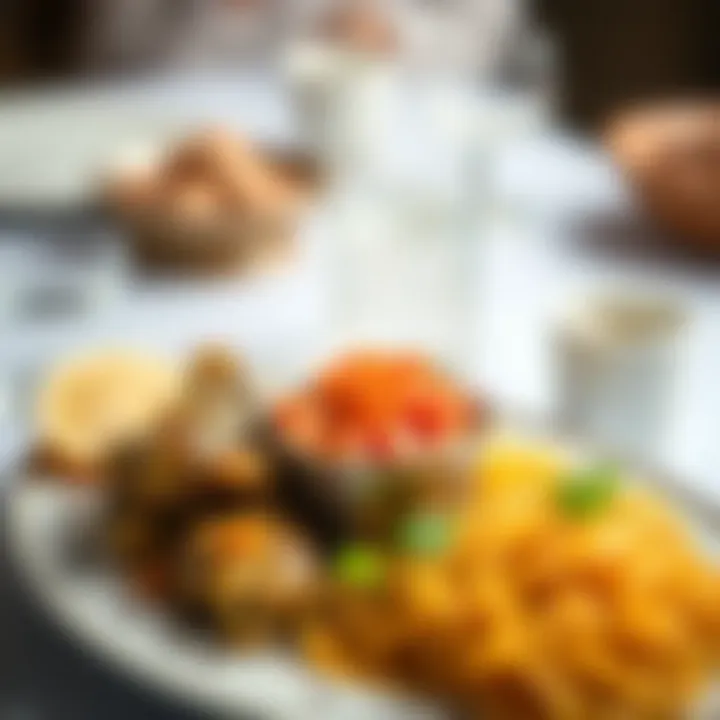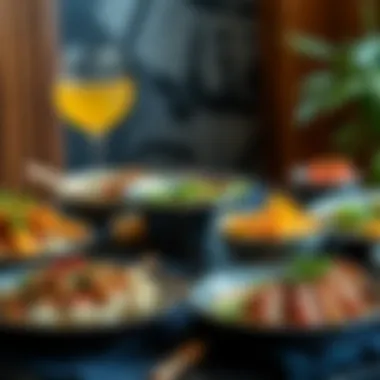Exploring the Culinary Treasures of the UAE


Intro
The United Arab Emirates (UAE) stands as a remarkable testament to the fusion of diverse cultures, a vibrant blur of tradition and modernity where every dish tells a story. From the bustling markets of Abu Dhabi to the chic restaurants in Dubai, the culinary scene of the UAE is as multifaceted as its heritage. This article sets out to unravel the rich tapestry of Emirati cuisine, examining not just what is on the plate, but what it signifies about the people and history of this land.
Through dishes passed down through generations and modern interpretations that push boundaries, each item reflects the melting pot of influences that have shaped the UAE's culinary identity. By delving into the flavors, preparations, and historical backgrounds, we glean insight into how food aids in defining community and celebrating traditions.
The UAE's gastronomy offers a flavorful journey through the ages, leaving a lasting impression on anyone fortunate enough to indulge in its offerings. As we embark on this exploration, prepare to uncover the hidden gems nestled within the kitchens and markets of this radiant country.
Preamble to UAE Cuisine
The culinary landscape of the UAE is a vivid tapestry woven from rich histories, cultures, and flavors. In this piece, we delve into the intricacies of Emirati gastronomy, revealing how the present-day offerings of the nation are deeply rooted in its past. By understanding the fundamentals of UAE cuisine, one gains not just insight into flavors, but also a glimpse into the nation’s identity. This journey through gastronomy aids in showcasing not only the beloved traditional dishes but also the intriguing modern adaptations that embody this unique region's spirit.
Cultural Influences Shaping Emirati Food
Taking a closer look, one cannot ignore the myriad of cultural influences that have sculpted Emirati cuisine. The UAE, located at the crossroads of continents, has historically been a melting pot of trade and cultural exchange. As spices flowed into the region via trade routes from India, Persia, and East Africa, they found a permanent home in the kitchens of Emirati households.
Notable aspects include:
- Diverse Spice Palette: Incorporation of warming spices like cumin, coriander, and cardamom shapes the distinct flavors of many dishes.
- Historical Trade Influence: The pearling industry and maritime trade brought in a variety of food items, resulting in a fusion of flavors and cooking techniques.
- Communal Eating Tradition: In Emirati culture, sharing meals together is a significant practice that reflects hospitality and togetherness.
"The essence of Emirati food lies in its heart — the family gatherings that celebrate both the meal and the company."
This culinary journey reveals a tapestry not just of taste, but of stories passed down through generations. Observing how these cultural influences blend and interact underscores the dynamism of Emirati food. The technique of slow-cooking meats or marinating fish with local spices elevates simple ingredients into something profound and irresistible, showcasing both diversity and unity.
The Fusion of Tradition and Modernity
As time marches on, the culinary scene in the UAE is not stagnant. There's an interesting dance between the old and the new. Traditional dishes—often hand-crafted with care for generations—are being reinterpreted, providing an exciting platform for culinary innovation.
- Contemporary Chefs: Today's chefs often draw inspiration from traditional recipes while adding a modern twist, resulting in unique creations that both honor the past and look to the future.
- Flavorful Experiments: For example, traditional Al Harees might find itself paired with unexpected flavor infusions, each chef adding their signature touch.
- Local and Sustainable: There's a growing emphasis on local, organic ingredients, highlighting the freshness that the region has to offer.
The fusion of tradition and modernity speaks to the resilience and adaptability of Emirati cuisine. These transformations provide not just a feast for the palate but also a reflective lens on the evolving identity of the UAE as it embraces its roots while reaching for a burgeoning future.
In summary, understanding the foundational influences and evolving nature of Emirati food enriches the appreciation for its unique offerings. The blend of cultural heritage and innovative approaches makes UAE cuisine a remarkable field of exploration.
Staple Ingredients in Emirati Cooking
The essence of Emirati cooking lies not merely in the dishes themselves, but in the ingredients that form the backbone of this remarkable cuisine. Staple ingredients in Emirati cooking serve as more than just flavor enhancers; they tell the history and culture of a region shaped by trade, climate, and traditions. By delving into these essential components, one gains a deeper understanding of the narratives interwoven into every bite.
Spices and their Significance
Spices play a pivotal role in Emirati cuisine, framing its complex flavors while creating aromas that transport one to bustling souks and grand family feasts. Traditional Emirati cooks utilize a myriad of spices, each having its own story and use. For instance, cumin and coriander form the foundation of many spice blends. These spices often reflect the country's trading past, as merchants exchanged goods, and culinary knowledge flowed between diverse cultures.
In contemporary kitchens, spices like saffron and cardamom are not just for flavor; they are seen as symbols of hospitality and wealth. Their rich aromas evoke a warm welcome, making meals not just about nourishment, but about connection.
"In Emirati tradition, spices are like friends—each enhancing the strength and beauty of the other."
Such is their significance that gatherings often revolve around the process of blending and using these spices. Whether it's the comforting scent of baharat wafting from a mother's kitchen or the traditional use of khaleeji spices in meat dishes, each one plays a role in defining the culinary identity of the region.
Commonly Used Proteins


The protein choices in Emirati dishes offer a glimpse into the lifestyle and values of the citizens. Lamb, goat, and chicken are among the most favored. Lamb, known for its tenderness, often appears in Al Harees and other festive meals. The way it is prepared—slow-cooked and marinated—mirrors a communal spirit, as families gather around to share their meals.
Chicken, often cooked with spices or grilled, serves both elegance and practicality, making it a staple for everyday dinners. Fish and seafood also dominate coastal areas, emphasizing the region's reliance on the ocean. Grilled fish with some rice symbolizes both freshness and simplicity.
Also noteworthy are the protein-rich legumes like chickpeas, crucial in vegetarian meals, echoing a balanced dietary approach. Their presence highlights the cultural embrace of health, further intertwining with the UAE's commitment to well-being.
Vegetables and Grains in Traditional Dishes
Grains and vegetables in Emirati cooking speak to sustainability and resourcefulness born out of the harsh desert environment. Rice stands as a cornerstone, often complementing dishes such as Mandi. It’s usually flavored with saffron and spices, turning a staple into a cultural centerpiece.
In terms of vegetables, using local produce is common. Ingredients like tomatoes, potatoes, and onions serve as base notes for many stews and sauces. These vegetables are not just fillers; they embody the essence of family cooking where each ingredient is valued.
Lentils are also prevalent, often transformed into rich stews paired with rice. Their adaptability reflects the practical aspects of cooking in a diverse household. Adding seasonal vegetables to the mix highlights the Iris commitment to fresh and clean eating, a principle revered by many Emirati families.
Traditional Emirati Dishes
Emirati cuisine is a tapestry woven from the rich threads of history, culture, and communal ties. The traditional dishes not only deliver tantalizing flavors but also embody the spirit of the UAE. Each meal tells a story – of hospitality, heritage, and the unifying power of food. Delving into these traditional dishes offers a window into the past, revealing how influences shape what is served today.
Whether it’s a festive gathering or a casual meal at home, the cornerstone of Emirati culture is often found at the dining table. Emirati recipes reflect the geography, climate, and resources of the region. They celebrate the country's history of trade and cultural exchanges with neighboring lands. The inclusion of spices and specific ingredients can often trace back to ancient interactions, which is another reason exploring these dishes is essential.
Al Harees: A Time-Honored Delight
Al Harees holds a special place in Emirati hearts, especially during Ramadan and weddings. Made with just two primary ingredients – wheat and meat, often chicken or lamb – it requires hours of slow cooking, traditionally done in a clay pot. The dish is cooked until the wheat breaks down into a porridge-like texture. This meticulous preparation is more than just cooking; it’s a labor of love and community.
"To eat Al Harees is to hold a piece of tradition in one’s hands."
Eating Al Harees connects individuals with the past, reinforcing bonds within families and communities. The savory flavor, combined with a touch of salt, symbolizes sharing and generosity, aptly capturing the essence of Emirati hospitality. In these moments, food transcends mere sustenance; it nurtures relationships.
Mandi: The Flavors of the Desert
Mandi is akin to an aromatic symphony, harmonizing tender meat, fragrant rice, and a blend of spices that evoke desert landscapes. Originating partly from Yemen, this dish has become a staple in Emirati cuisine. The cooking technique involves slow roasting meat with spices, often under the sand or in a specially designed clay oven. The rice absorbs the meat's rich flavors, creating a dish that is both hearty and luxuriously aromatic.
Mandi is usually served on a large platter, ideal for communal sharing. This aspect reflects the Emirati culture of bringing friends and family together, making Mandi a centerpiece at major celebrations. It brings a diverse crowd together, where everyone digs in, a mingling of flavors and conversations.
Shawarma: A Culinary Icon
Shawarma, a beloved street food, may not be traditionally Emirati but has been embraced with open arms by locals. This dish is a perfect fusion of flavors, where marinated meat—often chicken or beef—is stacked vertically and cooked on a rotating spit until perfectly juicy. The thinly sliced meat is usually rolled into pita bread, accompanied by tahini, pickles, and fresh veggies, creating a vibrant burst of taste.
Shawarma trucks and eateries are sprinkled throughout urban areas, serving both locals and tourists alike. The convenience and flavor have allowed Shawarma to qualify as an international sensation while maintaining a local twist that embodies Emirati hospitality.
In summary, traditional Emirati dishes serve as a testament to the nation’s rich culinary history. Each dish formulates connections, tells stories, and embodies the heritage of UAE. To truly grasp the essence of Emirati dining is to embark on a sensory journey that feeds both the body and soul.
Sweets and Desserts in Emirati Culture
Sweets and desserts hold a prominent place in Emirati culture, often symbolizing hospitality and the warmth of community spirit. Whether it's during festive occasions or simple gatherings, these treats signify more than just indulgence; they are a celebration of heritage and tradition. In this section, we delve into two beloved sweets - Kunafa and Baklava - to uncover their significance and explore their delightful flavors.
Kunafa: A Sweet Indulgence
Kunafa is a beloved dessert that transcends borders, but in the UAE, it takes on a unique flair. This pastry, often enjoyed hot and fresh from the oven, features a delightful combination of shredded phyllo dough or fine semolina, layered with creamy cheese or a nutty filling. The sweetness is heightened by a fragrant syrup made from sugar, rose water, and sometimes a hint of pistachio.
The preparation of Kunafa is not just about cooking; it involves a ritual of gathering family and friends to watch as the layers are masterfully crafted. The result is not just a dish but an experience, one where the aroma wafts through the air, enchanting anyone nearby. Often enjoyed with a cup of strong Arabic coffee, Kunafa encapsulates the delicate balance between sweetness and bitterness, a reflection of life in the region.


Some popular variations of Kunafa throughout the UAE include Kunafa Nabulsiah, which originates from Nablus, Palestine. This version showcases a rich and creamy interior, while some tap into extravagant toppings like crushed pistachios or a sprinkling of coconut.
Kunafa is more than a dessert. It's a moment to savor, a connection to the past, and a reason to gather.
Baklava: A Symbol of Hospitality
Another sweet that deserves a rightful place in any discussion about Emirati desserts is Baklava. This layered pastry is crafted with a love that resonates deeply within the culture, being a staple in both daily life and festive occasions.
Composed of thin sheets of phyllo dough, Baklava is generously filled with finely chopped nuts, usually almonds or walnuts, and seasoned with aromatic spices like cinnamon. After being baked to golden perfection, it’s soaked in a syrup that adds an exquisite syrupy glaze. Each bite offers a symphony of textures: the crunch of nuts, the flakiness of pastry, and the sweetness of syrup come together in harmony.
Baklava is often served during family gatherings and festive seasons, reinforcing its role as a symbol of hospitality. When approaching a family home or a festive event, it’s not uncommon to be greeted with a plate of Baklava, emphasizing generosity and warmth. The act of sharing Baklava signifies trust and kinship, illustrating the interweaving of food and relationship bonding in Emirati culture.
While Baklava is known worldwide, its significance in the UAE comes from how it is served and savored. It's more than just a dessert – it’s a gesture of inclusion, a marker of life’s joyful moments.
The Role of Food in Emirati Hospitality
Food is not just about nourishment in Emirati culture; it’s a cornerstone of hospitality and a vital part of social fabric. Anyone who has visited the UAE, or even just been to an Emirati home, can attest to the generous and warm nature of their culinary traditions. Meals serve as a bridge—bringing people together, transcending boundaries, and fostering relationships that might not otherwise flourish.
Serving Traditions and Rituals
When it comes to serving food, the rituals and traditions are as significant as the dishes themselves. In many Emirati households, you may encounter a beautiful large platter at the center of the table, filled with aromatic rice and tender meat, often accompanied by an assortment of colorful salads and dips. The act of sharing food is paramount, symbolizing unity and kindness.
It's customary to serve the guest first, a practice steeped in the belief that hospitality is a reflection of respect. As one digs in, they might notice the importance of using the right hand for eating, a longstanding tradition in many parts of the Arab world. This ritual is not merely a matter of taste but of culture. The following are key aspects often highlighted during these serving traditions:
- Emphasis on Generosity: “More than enough” is often the motto, with hosts ensuring that no guest leaves feeling unsatisfied.
- Use of Hands: Eating with hands signifies a connection to the food, and it fosters a more communal atmosphere.
- Coffee and Dates: Usually, guests are welcomed with Arabic coffee, a sign of respect, accompanied by dates—a sweet start to a savory meal.
These rituals are embedded in every bite, making each meal not just a combination of ingredients but an experience filled with history and meaning.
Community Gatherings and Feasts
In the Emirates, food also plays a pivotal role in community gatherings. Feasting during special occasions is another facet that showcases the importance of food in Emirati life. Events like weddings, Eid celebrations, and various local festivals bring communities together. On these occasions, tables groan under the weight of countless dishes, each offering a different tale of flavors and tradition.
Highlights of Community Feasts
- Mandi and Kabsa: Often the star of community feasts, these rice dishes are prepared in massive quantities, symbolizing togetherness.
- Traditional Music and Dance: Amidst the vibrant aromas, live music and dance bolster the celebratory atmosphere, weaving food into the cultural tapestry.
- Meet and Greet: A gathering wouldn't be complete without stories shared over the meals, creating bonds that are often unbreakable.
In essence, food in Emirati hospitality is a celebration of community. It is a rich fusion of flavors, traditions, and heartfelt connections that leave a long-lasting impact on everyone involved. By exploring the depths of these gastronomic experiences, one gains insights into the culture itself, revealing how deeply intertwined food is with Emirati identity.
"In Emirati culture, every meal signifies more than just food; it’s a heartfelt welcome, a shared experience, and a mark of deep respect."
For further insights into the cultural significance of food beyond the UAE, you might find this information useful:
Understanding these traditions not only enriches one’s culinary knowledge but also enhances the experience for expatriates and travelers who wish to forge genuine connections with the local populace.
Contemporary Adaptations of Traditional Dishes
The cuisine of the United Arab Emirates is not static; it evolves just like the nation itself. Contemporary adaptations of traditional dishes reflect a dynamic interplay between the past and the present. As the UAE finds itself squarely at the crossroads of heritage and innovation, culinary experts and home cooks alike are reinterpreting age-old recipes to align them with modern tastes and lifestyles. This adaptation is not merely about altering flavors but encapsulates a broader cultural dialogue that considers global influences, health trends, and the Emirati identity. The importance of this topic cannot be overstated; it serves as a lens through which one can observe the shifting paradigms of a society that is both deeply reverent of its traditions and boldly forward-thinking.
Fusion Cuisine in Dubai


In the melting pot that is Dubai, fusion cuisine has become a defining characteristic. This vibrant city combines elements from diverse cultures into existing Emirati dishes, creating a culinary landscape rich in variety and flavor. For instance, you may find a Lamb Mandi served with a side of Thai green curry, showcasing influences from both the Middle East and Southeast Asia. This cross-cultural exchange has birthed unusual, yet harmonious dishes that cater to the cosmopolitan palate.
- Innovative Restaurants: Establishments like Zahrat Lebnan and Coya challenge convention, offering dishes that marry traditional Emirati spices with international cooking techniques.
- Global Ingredients: Chefs are increasingly using unique ingredients, such as avocado or miso, in traditional recipes, drawing inspiration from global culinary trends.
This innovation doesn’t just enhance the dining experience; it encourages community engagement. Food festivals and pop-up markets often highlight these fusion dishes, helping to establish a unique culinary identity that connects Emiratis with other cultures.
"Food is a universal language, and in Dubai, it speaks a multitude of dialects," notes a local food enthusiast. "Each dish tells a story of migration and adaptation, making dining an adventure of cultural discovery."
Health-Conscious Variations
As awareness of health and wellness grows, so do health-conscious variations of traditional dishes in the UAE. Emirati cooks and restaurants are making strides in reducing unhealthy fats and sugars, offering alternatives that maintain the spirit of traditional flavors while catering to modern dietary preferences.
Specific aspects to highlight include:
- Ingredient Substitutes:
- Creative Approaches to Cooking:
- Focused Nutritional Content: Consumers are increasingly seeking out dishes rich in fiber, vitamins, and minerals, spurring restaurants to innovate and feature these elements prominently on menus.
- Using whole grains instead of white rice in Majboos to boost nutritional content.
- Incorporating leaner proteins, such as chicken or fish, instead of red meats.
- Techniques like grilling or baking are gaining popularity over frying, which not only preserves the authentic tastes but also enhances the dishes' health profiles.
In this light, health-conscious variations aren't just changes to meals; they're part of a broader conversation about lifestyle and well-being in the UAE. They signify an awareness among Emiratis and expatriates alike about the importance of food in their daily lives, navigating the balance between pleasure and health with grace and ingenuity.
As the culinary landscape of the UAE continues to evolve, embracing contemporary adaptations is not just a trend; it represents a commitment to keeping culture vibrant, relevant, and accessible for generations to come.
The End: The Evolution of Emirati Cuisine
Food is more than sustenance; it acts as a mirror reflecting the history, culture, and social fabric of a people. The evolution of Emirati cuisine encapsulates a journey from deep-rooted traditions to modernity, celebrating the unique identity of the UAE. In this article, we've examined not just the dishes but the intricate stories and values they embody. Each meal serves as a thread in the rich tapestry of Emirati life, where past and future coexist harmoniously.
Changes in global diets, the influx of diverse cultures, and evolving cooking methods have transformed Emirati food into a dynamic culinary scene. This evolution highlights how important it is for continued preservation and adaptation of traditions, making local cuisines not just historical artifacts but living narratives.
The benefits of understanding this evolution are manifold. For expatriates and investors in the UAE, knowing the nuances of local cuisine can enhance social interactions, foster community ties, and even create business opportunities in food-related ventures. Similarly, homeowners looking to engage with their neighbors or clients will find that sharing a meal or learning about local traditions can bridge cultural divides.
"Food is not just about what you eat; it’s about the stories you share and the relationships you build."
In summary, analyzing the evolution of Emirati cuisine provides invaluable insights into the fabric of Emirati identity and the growing influence of modern, globalized culture. To appreciate its depth is to understand a piece of the UAE’s soul.
Preserving Traditions in a Modern World
In a fast-paced world that constantly changes, preserving culinary traditions has become a crucial undertaking for Emirati culture. Traditional practices, along with locally sourced ingredients, are foundational to the identity of Emirati cuisine. Dishes like Al Harees and Mandi hold a special place in social gatherings and celebrations, passed down through generations.
Despite the rapid modernization, the essence of traditional cooking methods is being kept alive through initiatives aimed at educating the younger population. Culinary schools in the UAE, like the Emirates Culinary Guild, strive to incorporate traditional Emirati recipes into modern cooking classes, ensuring that the younger generation remains connected to their heritage.
Moreover, food festivals and cultural events often showcase traditional recipes, serving as platforms for artisans and chefs to share their skills and stories. These events not only foster a sense of community but also serve as a reminder of the flavors that have shaped the nation.
- Use of local ingredients reinforces sustainability.
- Strengthens community bonds through shared meals.
- Helps maintain the unique flavors that define Emirati cuisine.
By nurturing these traditional practices, Emiratis can celebrate their roots while embracing new influences.
The Future of UAE Culinary Arts
Looking ahead, the future of Emirati culinary arts seems promising. As the world becomes more interconnected, the UAE's culinary scene is poised to blend its traditional strengths with global innovations. The rise of fusion cuisine, particularly in cities like Dubai and Abu Dhabi, showcases this evolving landscape.
Chefs are reimagining classic dishes, introducing new flavors and techniques while still paying homage to their roots. For example, a modern take on shawarma might incorporate spices from Southeast Asia or even innovative cooking methods such as sous-vide, blending culinary techniques from around the globe with local fare.
As every nation moves towards health-conscious eating, we see a shift in Emirati cuisine towards lighter, healthier options. Traditional ingredients like dates, lentils, and locally sourced vegetables are finding their way into innovative recipes that cater to a more health-aware audience. This not only keeps the cuisine relevant but also introduces traditional flavors to a new demographic.
In summary, the UAE is at a culinary crossroads where tradition meets innovation. This blending of influences not only respects the past but also creates a vibrant culinary art scene that can adapt to future trends without losing its unique identity. For real estate agents, investors, and expatriates, these culinary shifts present interesting opportunities for cultural engagement, market potential, and community connection.









